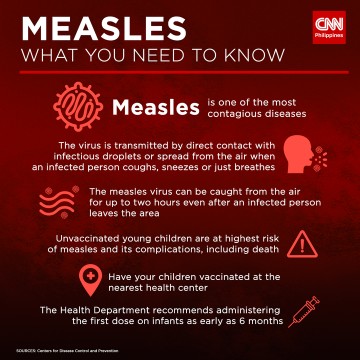Metro Manila (CNN Philippines, February 8) — More than 70 people have died this year due to measles after the Health Department declared an outbreak of the highly contagious disease in different regions.
Department of Health (DOH) Spokesperson Enrique Domingo reported around 72 deaths among more than 2,000 cases of measles nationwide. Fifty five of the deaths were from San Lazaro Hospital, Manila in January alone.
“All over the country I think we have more than 2,000 cases and we’ve had deaths, in San Lazaro alone we have 55 deaths in January,” Domingo told CNN Philippines’ New Day.
In CALABARZON, Domingo reported nine deaths, while in Region III there were four deaths from measles. The DOH also recorded three deaths in Region VI (Western Visayas) and one death in Region VII (Central Visayas), Domingo said.
Meanwhile, an initial report from the Health Department also recorded two deaths in Ilocos Region and one death in Bicol Region from January 1 to January 26, 2019.
This comes after the DOH declared a measles outbreak in Metro Manila and Central Luzon on Wednesday and in CALABARZON, Western and Central Visayas on Thursday.
Health officials attributed the rising number of measles cases to a long-term decline in vaccination coverage. According to DOH records, 960,457 children have not been vaccinated for the first three quarters of 2018, a spike from its 2017 figure of 855,039.
On the other hand, the World Health Organization (WHO) said there are about 2.5 million children below five years of age in the Philippines who are susceptible to measles due to lack of appropriate vaccination.
WHO Representative to the Philippines Dr. Gundo Weiler said the outbreak did not come as a surprise to them given the low coverage of the country’s immunization program.
“We are not very surprised about this. This is a situation that could have been predicted. It’s against the background of low immunization coverage we have seen here in the country over the last years,” Weiler said in an interview with CNN Philippines.
He explained that a country must achieve a 95% coverage for its immunization program to ensure that communities will be protected from the disease. However, in the last few years the Philippines has maintained only 70 to 80% coverage and this dropped even further to close to 60% in 2018.
This has lead to a periodic pattern of measles outbreaks every three to four years, Weiler added. A measles outbreak was declared in 2011, 2014 and 2018 before the epidemic this year.
“What is happening now is we have a big campaign with a lot of investment to catch up with immunization. After that big campaign, we’ll be quiet for a few years but as long as we don’t strengthen routine immunization, again we’ll fall back into the same pattern,” Weiler said.
Domingo explained that children can receive vaccines as young as six months old if their mothers have not been vaccinated. If the mother has been vaccinated, the child can receive the vaccine by nine months old.
“It’s safe. Usually we give that nine months old because assuming that the mother is vaccinated or has measles antibodies and at birth during breastfeeding they can give the antibodies to the children, which usually protects them until nine months old,” he said.
Domingo assured that the government has enough supplies of vaccines to provide for vulnerable communities.
“We have enough supplies because every year the Philippines buys enough vaccines to cover the whole vulnerable population and this year we ordered extra doses from UNICEF (United National International Emergency Fund),” he said.
He added that they are also coordinating with the Philippine Red Cross to set up temporary tents, specifically in San Lazaro Hospital, to admit more patients.
Source: http://cnnphilippines.com/news/2019/02/08/over-70-deaths-measles-outbreak.html








